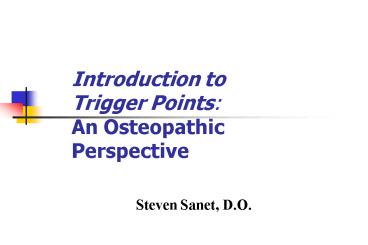Introduction to Trigger Points: An Osteopathic Perspective - PowerPoint PPT Presentation
1 / 16
Title:
Introduction to Trigger Points: An Osteopathic Perspective
Description:
Muscle in the immediate vicinity of a TP feels tense to palpation. ... Snapping palpation of the TP frequently evokes a local twitch response. ... – PowerPoint PPT presentation
Number of Views:1280
Avg rating:3.0/5.0
Title: Introduction to Trigger Points: An Osteopathic Perspective
1
Introduction toTrigger Points An Osteopathic
Perspective
- Steven Sanet, D.O.
2
History
- 1800s - Germans Muskel schmerzen
- 1843 - Froriep Musckelschwiele
- 1919 - Eversbusch Muskelharten
- 1938 - 1957 Good Myalgic spots
- 1945 ? Travell Trigger points
3
Characteristics
- May or may not be a palpable mass
- Hyperirritable locus within a muscle
- Pain on compression or irritation
- Tremor or fasciculation on compression or
irritation - Refers pain with or without autonomic phenomena
4
Terminology
- Active TP - A focus of hyperirritability in a
muscle or its fascia that is symptomatic with
respect to pain it refers a pattern of pain at
rest and/or on motion that is specific for the
muscle.
5
Terminology
- Associated TP - A focus of hyperirritability in a
muscle or its fascia that develops in response to
compensatory overload, shortened range, or
referred phenomena caused by trigger point
activity in another muscle. AKA Satellite
and Secondary TPs
6
Terminology
- Latent TP - A focus of hyperirritability in
muscle or its fascia that is clinically quiescent
with respect to spontaneous pain it is painful
only when palpated.
7
Potential Causes of Trigger Points
- Acute/chronic injury or illness
- Excessive repetitive movements
- Chilling of the muscle
- Nervous tension or stress
- Tender point of long duration
- Active primary point causing secondary TP
- Latent TP activated by any of the previous
8
Neurophysiological Model
9
Osteopathic Model
10
Histological Changes
- Fatty infiltration
- Increased number of nuclei
- Serous exudates
- PG, GAG deposits
11
Physical Findings on Examination
- Passive or active stretching of the affected
muscle increases pain. - Stretch ROM of the affected muscle is restricted.
- Pain is increased when the affected muscle is
strongly contracted against a fixed resistance. - Maximum contractile force of an affected muscle
is weakened.
12
Physical Findings on Examination
- Deep tenderness and dysesthesia is referred to a
zone away from the TP. - Disturbances of non-sensory function are
sometimes induced in the pain reference zone. - Muscle in the immediate vicinity of a TP feels
tense to palpation. - There will be a point of maximum tenderness.
13
Physical Findings on Examination
- Digital pressure to an active TP elicits a jump
sign. - Snapping palpation of the TP frequently evokes a
local twitch response. - Moderate, sustained pressure of a TP causes or
intensifies pain in the TP reference zone. - The skin of some patients may show dermatographia
in the area overlying an active TP.
14
Sternocleidomastiod Trigger Point Referral Pattern
15
Treatment Should Include the Following
- Address contributing factors
- Identify normalize all somatic dysfunctions
- Stress management
- Improve level of physical fitness
- Improve overall state of health
16
Common Techniques Approaches
- Injection/Needling followed by Stretch
- Spray Stretch or Ice application Stretch
- Counterstrain followed by Stretch (Combined
Technique) - Functional/Positional Release
- Deep Digital Inhibition followed by Stretch
- Myofascial Release
- Muscle Energy
- HVLA (only effective if underlying osteoarticular
dysfunction is driving the Trigger point)































